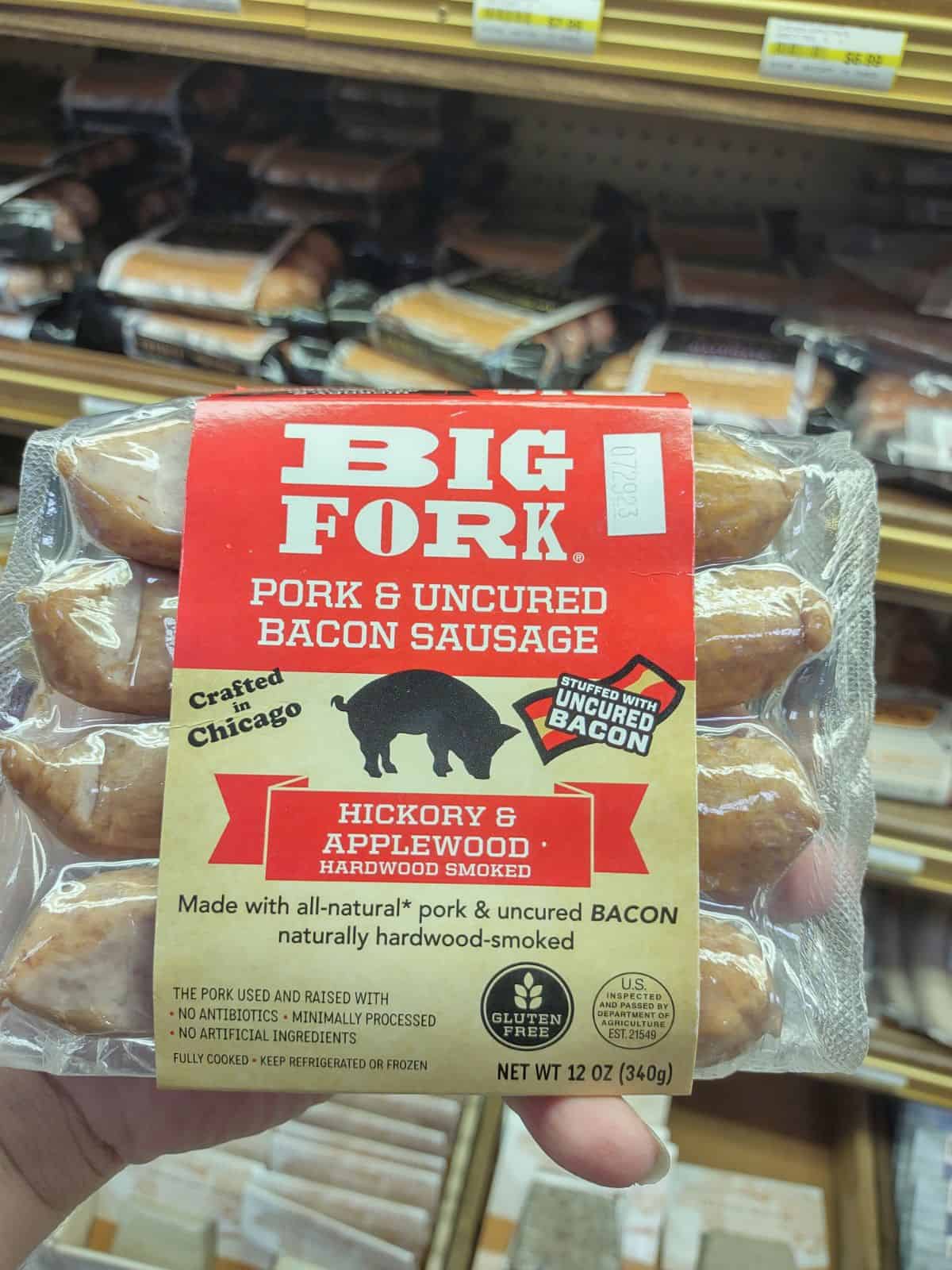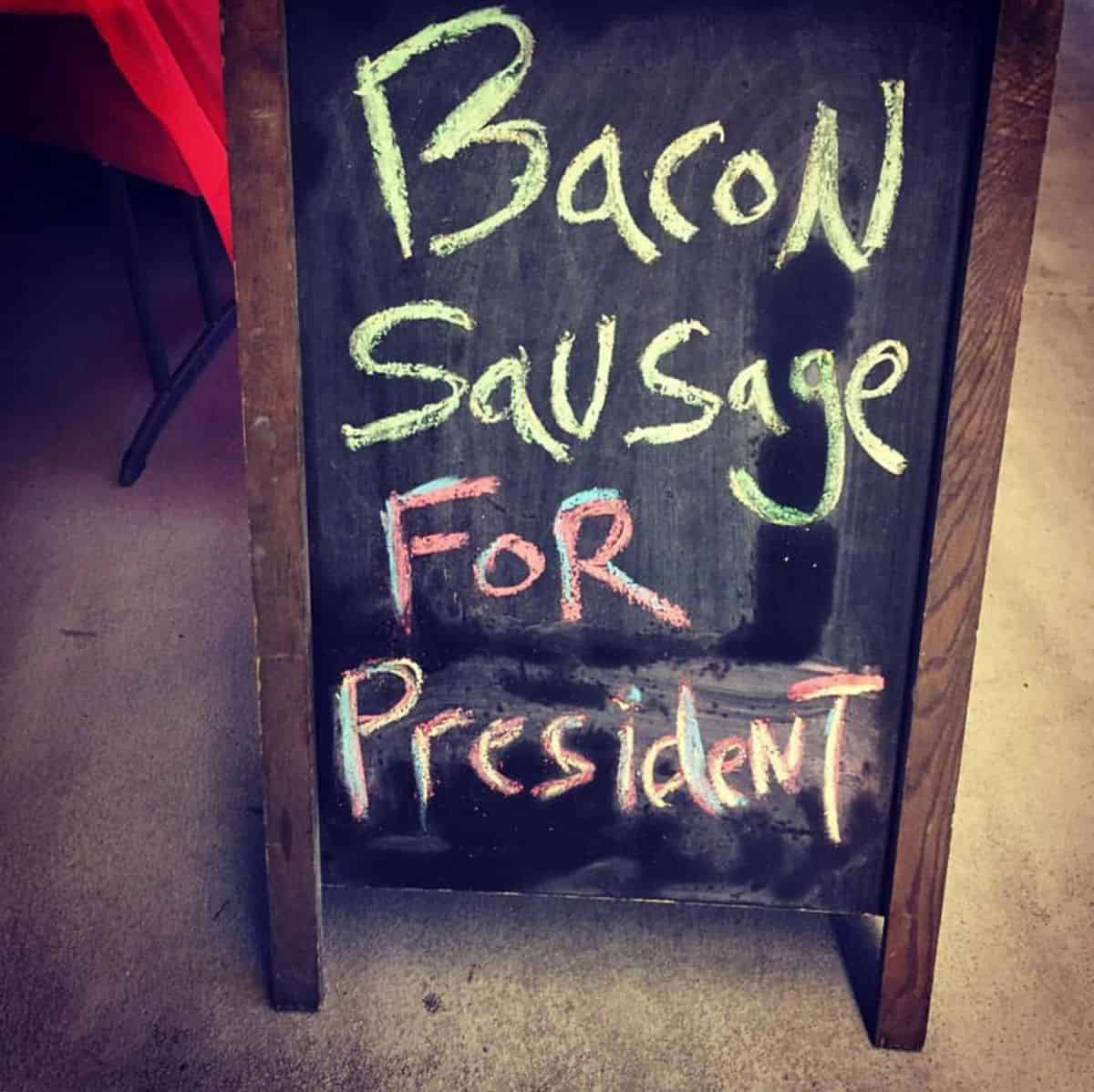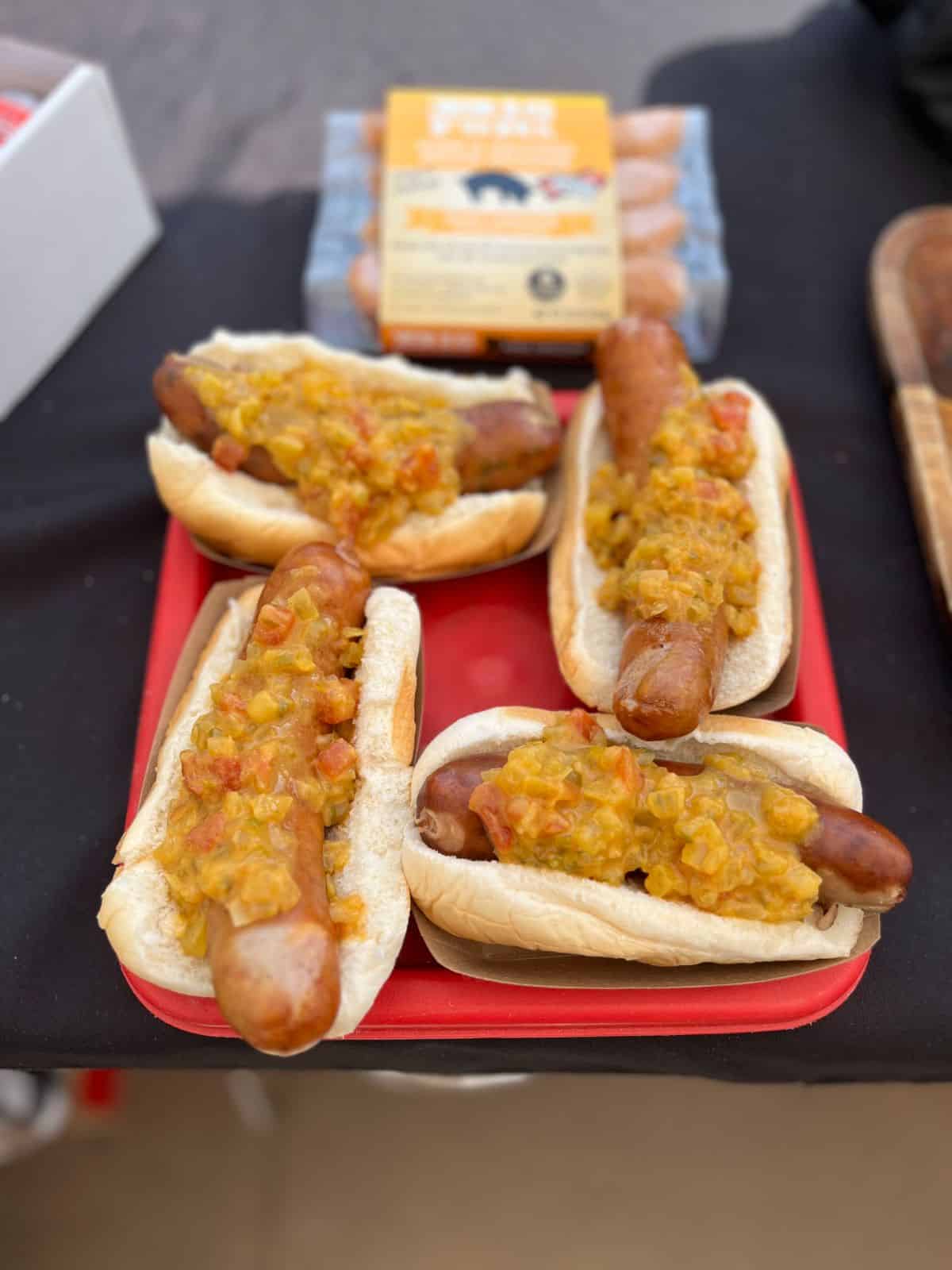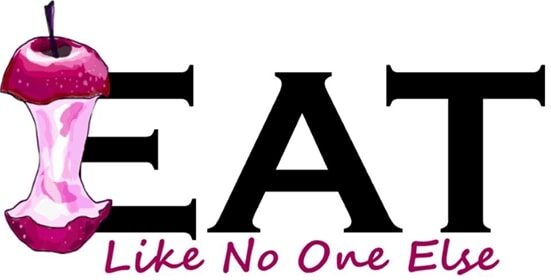Bacon or sausage. Sausage or bacon. Why not both? In this episode, I have Lance from Big Fork brands on to talk about how they fill their already amazing sausage with bacon! Yum!
This post includes affiliate links. This means that, at no additional cost to you, I will earn a commission if you click through and make a purchase. These are products and services I recommend because I use or trust them. Cookies will be used to track the affiliate links you click.
Jump to:
🎧 Listen
You can listen to this podcast episode below or listen on any of these podcast players - Spotify, Apple Podcasts, Amazon Music, Google Podcasts. If you would prefer to read the text, you will find a transcript below.
📜 Read
Here is a transcript of the interview with Lance from Big Fork Brands
Eric: All right, everybody. Today, I'm excited to have Lance with me. Here's here representing Big Fork Brand. So, uh, welcome to the podcast, Lance.
Lance: Hey, happy to be here, Eric. Thank you.

🍴 What is Big Fork Sausage?
Eric: All right. So tell us a little about who is Big Fork and what kind of products do you make?
Lance: Yeah, so Big Fork started back in 2011 and with this whole idea of combining the two super meats into one, both bacon and sausage. And you know, then it's over the years it's morphed into an expanded line. We now have Craft Pork Jerky, a line of meat sticks, and then a line of unique sauces, that are kind of a Chicago centric, we call them Chicago sauce.
Where we take the seven toppings of the Chicago hot dog and turn that into one iconic sauce. And then we have a, a spicy version that we call Chicago fire sauce. And then it takes Chicago sauce and blend it with mayo and ketchup. And you got Chicago fry sauce.

Eric: Awesome. So, so for those who are not familiar with the Chicago style hot dog, what does that involve?
Lance: So it's, you know, they, they say, they run it through the garden and these are like, there's little, iconic hot dog stands throughout Chicago. It started, um, I, uh, really around the, turn of the century. And then, when, the depression hit, it was actually one of the cheaper ways to get a, a meal, um, in, in Chicago.
And basically they put, um, there's seven toppings. So there's tomatoes. Onions, peppers, celery salt, um, mustard, sweet relish and pickles. I'm not sure, but there's seven toppings anyway. And so that's all, it's super flavorful. I think it's the best tasting hot dog out there in the marketplace.
And, you know, what we just want to do is just kind of glorify one of these iconic, , dishes in Chicago. And what we ended up finding is that it's actually a really good sauce, not only for encased meats, but for, man, just a lot of different applications. I put it on eggs, um, in the morning, uh, especially the fire sauce.
It's just like, it's like a more flavorful hot sauce. And, um, so it's just, you know, there's just so many cool little applications that we're just finding beyond, obviously putting on hot dogs or other encased meats.
Eric: Sure. Absolutely.
Lance: you know, yeah, yeah.
Interested in trying out the sauces? You can order them on Amazon - Original Chicago Sauce, Chicago Fire Sauce, and Chicago Fry Sauce

🌭 How They Make Their Sausage
Eric: So let's talk about the sausage. That's where I was introduced to you guys. I found it, let's see here,, I'm trying to remember off hand where I found it for the first time. The most recent place I saw it was in the Cincinnati area and then there's a huge grocery store down there called Jungle Jim's, which is like the, it just, this massive store. Um, so I found it down there recently.
So, what do we find in your sausages? And also, maybe, what do you not find, you know, in your sausages that sets you guys apart?
Lance: Right, right. I think, you know, we, we kind of take this very traditional approach to our sausages where, um, they're hardwood smoked. And so there's no liquid smoke. liquid smoke is kind of a shortcut to, to actual creating smoke and, and creating, you know, a good tasting sausage. But it lacks some of the depth and complexity. Then where we kind of, you know, where we differ from other sausages out there, we stuff as much bacon into every encased meat that we do.
So, you know, that whole premise that, you know, bacon makes everything better. I like to say that we're just making sausage better with bacon. So, and then on top of that, , we actually use an organic, nitrite free bacon, um, that's GAP2 certified. So this is one of the second highest level of sustainability and humanely raised hogs. And then with our pork, you can't just put bacon into an encased meat, it would just be too fatty. So you have to have that delicate balance between fat and lean. And then we cut that with a Heritage Berkshire pork, which is.
These are, uh, Berkshire hogs that are raised outdoors by small independent family farmers in Iowa. So, um, I'm actually from Iowa. I'm an Iowa boy. So it's kind of, you know, pork is the number one product besides corn and soybeans here, that are raised here in Iowa. So actually that's where I'm at right now.
So, um, and, uh, so yeah, just that's, that's kind of the, uh, the unique take of Big Fork sausages.
Eric: Yes. And I tell you guys here, you know, if you haven't tried their sausage, it is amazing. You know, getting to have both at the same time, getting to have the bacon and it's so good. It's just so, so flavorful. And like you said, it's a, and it's well balanced, you know, that's the challenge here.
You're putting something fatty, you know, like, like bacon into sausage here. , you don't want it to be overly fatty. You want to have enough of that flavor, but it's, you know, they stay moist. They're, you know,
Lance: Yeah, it was, it was actually, um, I, I thought, I knew I had something, when it was actually much harder to create than I first thought. Um, and I actually, I've been doing product development, um. So I've got over, you know, 20 years of, uh, product development experience for my career, um, major CPG companies or, um, you know, ingredient companies, uh, in the world.
And so when I came up with this idea, I was like, Oh, I'll just whip this up together, no big deal. And then the next thing I knew, I was like, Oh man, this is pretty hard. So that's when I actually, I really felt like, um, we had something there because it wasn't something that, uh, can easily be replicated.
Eric: Exactly. You want it to be able to stand out and not just have everybody come in and do their own thing. And people, you know, everyone wants to replicate something that turns out good here. But, you know, It's easier said than done a lot of times, so that's great.
Lance: Exactly. Yeah. That's, we, we call that in our industry we're building fences around some of our intellectual property.

🥓 Sausage Flavors
Eric: That's a good way to put it, for sure. Um, so what kind of flavors can people find in your sausage?
Lance: So we used to have eight flavors of bacon sausage, but we ended up, we're, we're in kind of a, a paring down mode to kind of streamline our process, um, and expand our line and just, expand a wide net and see what, what works and then kind of reel back once we have our top flavors. But so, uh, moving forward, we're going to have five flavors.
Our hickory and applewood, which is kind of like our flagship original. It's our OG. That's just, and that name is based off of the two hardwood smokes that we use, um, in the smoking process.
Uh, basically. Hickory has some very great characteristics of smoke, and applewood also has great characteristics of smoke, but if combined, they actually, uh, they offset some of the negative aspects, so when combined, it's just the, it's the best smoke profile you can, that one can create.
Um, and then, uh, our next one is our aged cheddar. So basically we take the Hickory and Applewood flavor, and we just add, uh, aged cheddar cheese to it. And, I mean, bacon, cheddar, how can it go wrong?
Um, our third flavor is our maple and brown sugar. So, basically we double the amount of brown sugar that we have in Hickory and Applewood, and then we add just a ton of pure maple syrup, and it's like that, it's the breakfast of all breakfasts.
You know, like when they say, uh, would you like , bacon or sausage, this is kind of the same. This is like combining them. That's perfect for breakfast. And it's just got a little sweeter profile. Um, amazing. I love chopping it up and putting it in, you know, like using it instead of blueberries for like a blueberry pancake, chopping it up and then studding, and then flipping it over, um, and it caramelizes the other side of the pancake.
It's absolutely amazing.
Eric: Oh gosh, that sounds good.
Lance: Yeah , and then, we do have a, uh, a chicken sausage, um, that we call it, chicken and bacon. And then we use, The same bacon in there. So it's, it's a much leaner, and , lower calorie sausage for those out there that, um, that are concerned about that.
And then, um, and then we also have a, it's called the bacon and ale. We do a collaboration with two brothers and, we take their Abel Weiss beer and it's, you know, like once again, it's just like bacon and beer. And then, um, our final sausage that we use is our spicy three pepper, which is made with jalapenos, habaneros, and crushed red chilies.
And what's unique about that flavor? I've actually won four different cooking competitions with that sausage. It's a great, like, workhorse. Like if you're gonna, like, make you know, soups or stews or, you know, anything where you might use like, like a jambalaya, shrimp and grits, any of those types of dishes where you want, uh, some, some smoky sausage into a dish, that baby is awesome.
Eric: That sounds really good. I've tried the original before, but I definitely haven't tried all the different ones yet. I would definitely have to at some point. Um, yeah, so it's, it's a really, you know, going in the quality grades.
I know you talked about the, um, the smoke thing here, kind of, you know, combining the two different smokes, kind of find that nice, you know, which is really good. And, you know, what some people don't know, like you mentioned earlier about the liquid smoke, is like some places, you know, when you're getting like cheap sausage, you know, big factory produced, major, you know, sausage thing, you know, sausage or bacon here people like to use, you know, it's quicker process.
Let's just put smoke on it instead of actually smoking the meat here. And while it does, you know, taste, you know, it has some smokiness to it, you know. I mean, you could buy liquid smoke in the store just as a consumer. You can just go buy it here and you could dump it on something. I'm sure it could taste that way, but it doesn't have this complexity.
It doesn't have, you know, it's just like you're dumping. It's kind of like the idea of, you know, when you're cooking, you know, salting your food along the way, as opposed to just salting at the table, you know, so you're kind of just dumping salt on top. You're not adding the complexity and getting everything kind of in there, which is, you know, when you guys are doing, you know, with using, you know, wood chips and doing it that way.
Lance: Yeah, I like, I like to kind of compare it to if you're braising, um, your meat and, you know, you go through a searing process before you braise, or you just like, you just go and you dump it in some liquid and you just, uh, you know, kind of simmer it off, you're going to just. If you actually sear it, you, you know, you have that mallard reaction and it just, that the end dish is going to be so much more, uh, flavorful.
And it's just the same, you know, I, I'm a chef by trade. So there's certain, uh, you know, corners I'm not going to cut, I value more in, in when it comes to flavor than it does, you know, like cost considerations, you know, yeah, so we're not, we're definitely not the, uh, the cheapest sausage out there in the marketplace, but for, for good reason.
Eric: Yeah. Exactly. And, you know, you could, and there's all these different ways to, like, utilize things like that, too. Like, I will... Like, you know, make jambalaya or, or, you know, like, uh, or like, I, I like shrimp and grits, you know, so I, you know, those kinds of things you could, you could stretch things out further if you're like, you know, I have tight budget and need to, and you want to buy something quality, you know, instead of just eating, like, you know, just gonna like, you know, put it in a bun, eat it like a hot dog.
Um, you can, you can mix in with different things here, you know, it has a lot of flavors. So, you know, you can do those kinds of things. That's how I was with people, you know, it's, it's just, You know, you could buy the, you know, maybe spring for the more expensive meats and maybe you're going to scale back and how much you actually portion wise you're going to eat here, but mixing with good things like grits and good vegetables and those things here, and you got a great meal.
Lance:100%. Like, I think that, you know, uh, our sausage, just since they are so flavorful, you don't, and if you are going to use them in like in, in different, like more complex cooking methods, you don't need to use more than just a link or two. And you know, obviously it depends on how much you're making, but like it, that flavor just is, especially, you know, like when I was saying like the spicy three pepper, it is, there is also heat in there.
So you have, there's just so many complex, uh, flavor profiles that are actually just already cooked into that sausage. It just, it makes you, uh, it makes you a better cook. Yes, it is.
🐖 Where They Source Their Meat
Eric: Your meat is Iowa, being one of the top, um, pork, you know, or I think it's the top pork place. Right. Like number one.
Lance: Yeah. Number one. Yeah. Number one in the world.
Eric: In the world. I got too, I got too small minded there.
In the whole world. Um, so what else can you tell us about like, you know, some of the farmers and the places that you work with to source your meat?
Lance: Uh, yeah, so I, so I, you know, I think I mentioned it, but they're, uh, they're small independent farmers. So in Iowa. Like right after World War II, there was a real big focus, uh, into just the, you know, contract farming and these massive industrial farms.
And then around in the nineties, there was kind of this counterculture movement that, uh, really. You know, these farmers started to see the impact from an environmental perspective, the impact on the community with how, um, how bad these, these hog farms, how they smell and it was just bad for the environment, bad for the community around it.
And also it's just kind of like, started noticing that like the hogs just, they don't have a good life. So it's like, it's not good for, for anyone. So these, these farmers started, looking for alternative, ways of farming. And they went back to more of an old, I'd say an old school, um, more of the turn of the century type of, of farming where the hogs have, you know, 24 hour access to the outdoors and, uh, and they started looking into these heritage breeds, like Chester Whites or you know, we're a big fan of Berkshire, and what they found out is that they actually, they created a much better tasting, finished product.
Uh, the marbling in there is, um, is absolutely exceptional. And now these farmers, can charge a premium for this, premium pork. What's I think most interesting is that most of , this pork is actually exported to Japan.
Uh, the Japanese really, understand quality pork way better than, than the Americans. And so what I'm trying to do is, you know, educate the American palate and the consumer and try to keep a little more of these, these hogs and all this pork. Uh, domestically and just sell, um, sell it locally.
Eric: It's a great, it's a great mission. I've heard people talk about this before , especially those of, you know, older than me. About how pork doesn't taste the same anymore, you know, because I think, you know, I think like a lot of them, you know, modern, breeds we have out now, they're, you know, producing these mass quantities here, you know, like you said, you, you mentioned good marbling, you know, your pork, you're talking about good marbling, you know, most of the pork that we have now, it's just, it's just, you know, Bred to be so lean and people are always wondering like, How come my pork's dried out?
You know how it's so incredibly lean. It's so easy to dry out if you're not cooking it properly and you know, and I think a lot of us haven't really had the You know, and we finally have the super duper Cheap pork in the store because you know Look at the different cuts of meat out there. I mean, I mean if you're gonna save money, Eating pork is cheaper than eating beef, you know, it's gonna be cheaper in most case.
Yeah I mean you could you know find pork tests for super cheap
So, you like lower quality, but when you have like, you know, a good quality pork chop, you know, something like that, you know, or you eat your, your sausage here, which uses quality meat, it's like, whoa, this is what it's supposed to taste like here.
Lance: Oh, yeah, for sure. For sure. I mean, it's, uh, usually you get what you pay for, um, in, in the world of, of proteins and food. Um, you know, I, I think that's a, that's a. In the general rule, that's what you get. And yeah, I mean, there was this whole shift when chicken became like the, the dominant protein. Oh, and then, so the pork producers were like, Hey, we have to go, you know, it was the other white meat and we have to go really lean and all that stuff.
And, um, but I think with every, trend, there's always a counter trend to that. And, uh, so we kind of beat to our own drum and, and, uh, you know, try to create some, you know, interesting products that, um, that the main mainstream guys are not doing.
🛒 Where to Find Big Fork Products
Eric: I agree. Um, so before I let you go here, um, today, thank you for sharing all your great wisdom with us. Um, so where can people find your products?
Lance: I'd say the, the best and easiest way is online. Basically, our website, big fork brands.com. Um, that's where you can get, like, we have everything there. We have our sausages, we have our jerky, our meat sticks. Um, and our sauces there, you can find them, you know, like, yeah, down in like jungle gyms, you can get them in around Chicago at different, um, small independent, uh, retailers.
Uh, we also actually sell, actually, we sell most of our, sausage to, uh, to restaurants and hotels. So you might not even know it, but you might be getting it. Uh, some big fork sausage when you're at your local, breakfast joint or your bar and grill. And we, yeah, we sell nationwide, um, through Cisco, um, or European imports and a couple of the distributors like fortune fish and gourmet.
So it's, uh, yeah, it's all over. We also have our sauces, um, online on Amazon. So, um, and, and our jerky and our meat sticks, just not our sausage, just because it. Needs to be frozen. So it's, it's, um, yeah, so that's, that's in a nutshell where we, where we are, but yeah, you can always just look us up and then, you can also email us and say, Hey, I live in, you know, blah, blah, blah.
And we'll try to connect you with the closest retailer as well.
Eric: Thank you for coming out here and sharing all of your knowledge. And we, uh, I'm sure a lot of my, um, listeners right now are, should be hungry for that they haven't tried the amazing combo of putting sausage and bacon together, it's genius. And I love it. And I know you guys will all love it too, if you get a
Lance: Eric, thank you for taking the time.
Eric: Absolutely.


Leave a Reply